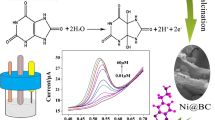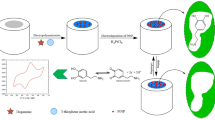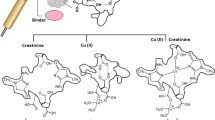Abstract
The article describes an electrochemical creatinine sensor that is based on a glassy carbon electrode (GCE) modified with a magnetic molecularly imprinted polymer (MMIP) and a composite consisting of nickel nanoparticles and polyaniline that was prepared by electropolymerization. Aniline and methacrylic acid were used as the bifunctional monomers, and creatinine was used as the template molecule. Electrochemical deposition was performed via cyclic voltammetry in the potential range from −0.3 V to 1.2 V and at a scan rate of 50 mV·s-1 over 20 cycles. The Ni@PANI NPs were characterized by scanning electron microscopy, FTIR, X-ray diffraction and thermogravimetric analysis. The Ni@PANI-modified GCE was characterized by cyclic voltammetry, electrochemical impedance spectroscopy and differential pulse voltammetry. Under optimized conditions, the sensor displays a linear response to creatinine in the 40 to 800 nM concentration range, with a 0.2 nM detection limit. The method was successfully applied to the detection of creatinine in urine mimic and in spiked urine samples.

Schematic of the preparation and function of an electrochemical sensor for creatinine. A glassy carbon electrode (GCE) was modified with a magnetic molecularly imprinted polymer (MMIP), nickel nanoparticles and polyaniline. The MMIP can specifically recognize creatinine to which it responds in the 40 to 800 nM concentration range.





Similar content being viewed by others
References
Li T-J, Chen P-Y, Nien P-C, Lin C-Y, Vittal R, Ling T-R, Ho K-C (2012) Preparation of a novel molecularly imprinted polymer by the sol–gel process for sensing creatinine. Anal Chim Acta 711:83–90
Chen JC, Kumar AS, Chung HH, Chien SH, Kuo MC, Zen JM (2006) An enzymeless electrochemical sensor for the selective determination of creatinine in human urine. Sensors Actuators B Chem 115(1):473–480
Jacobi D, Lavigne C, Halimi J-M, Fierrard H, Andres C, Couet C, Maillot F (2008) Variability in creatinine excretion in adult diabetic, overweight men and women: consequences on creatinine-based classification of renal disease. Diabetes Res Clin Pract 80(1):102–107
Wyss M, Kaddurah-Daouk R (2000) Creatine and creatinine metabolism. Physiol Rev 80(3):1107–1213
Taussky HH (1956) A procedure increasing the specificity of the Jaefe reaction for the determination of creatine and creatinine in urine and peasma. Clin Chim Acta 1(3):210–224
Sober HA, Hollander F, Sober EK (1950) Toxicity of Eugenol: determination of LD50 on rats. Exp Biol Med 73(1):148–151
Fossati P, Prencipe L, Berti G (1983) Enzymic creatinine assay: a new colorimetric method based on hydrogen peroxide measurement. Clin Chem 29(8):1494–1496
Lad U, Khokhar S, Kale GM (2008) Electrochemical creatinine biosensors. Anal Chem 80(21):7910–7917
Mohabbati-Kalejahi E, Azimirad V, Bahrami M, Ganbari A (2012) A review on creatinine measurement techniques. Talanta 97:1–8
Smith-Palmer T (2002) Separation methods applicable to urinary creatine and creatinine. J Chromatogr B 781(1–2):93–106
Chen S, Chen L, Wang J, Hou J, He Q, Liu J, Wang J, Xiong S, Yang G, Nie Z (2012) 2,3,4,5-Tetrakis(3′,4′-dihydroxylphenyl)thiophene: a new matrix for the selective analysis of low molecular weight amines and direct determination of creatinine in urine by MALDI-TOF MS. Anal Chem 84(23):10291–10297
Wei F, Cheng S, Korin Y, Reed EF, Gjertson D, C-m H, Gritsch HA, Veale J (2012) Serum creatinine detection by a conducting-polymer-based electrochemical sensor to identify allograft dysfunction. Anal Chem 84(18):7933–7937
Patel AK, Sharma PS, Prasad BB (2008) Development of a creatinine sensor based on a molecularly imprinted polymer-modified Sol-gel film on graphite electrode. Electroanalysis 20(19):2102–2112
Du J, Zhu B, Leow WR, Chen S, Sum TC, Peng X, Chen X (2015) Colorimetric detection of creatinine based on Plasmonic nanoparticles via synergistic coordination chemistry. Small 11(33):4104–4110
Mohammadi S, Khayatian G (2015) Highly selective and sensitive photometric creatinine assay using silver nanoparticles. Microchim Acta 182(7):1379–1386
He Y, Zhang X, Yu H (2015) Gold nanoparticles-based colorimetric and visual creatinine assay. Microchim Acta 182(11):2037–2043
Randviir EP, Kampouris DK, Banks CE (2013) An improved electrochemical creatinine detection method via a Jaffe-based procedure. Analyst 138(21):6565–6572
Wu S, Lan X, Huang F, Luo Z, Ju H, Meng C, Duan C (2012) Selective electrochemical detection of cysteine in complex serum by graphene nanoribbon. Biosens Bioelectron 32(1):293–296
Xue C, Han Q, Wang Y, Wu J, Wen T, Wang R, Hong J, Zhou X, Jiang H (2013) Amperometric detection of dopamine in human serumby electrochemical sensor based on gold nanoparticles doped molecularly imprinted polymers. Biosens Bioelectron 49:199–203
Mao Y, Bao Y, Gan S, Li F, Niu L (2011) Electrochemical sensor for dopamine based on a novel graphene-molecular imprinted polymers composite recognition element. Biosens Bioelectron 28(1):291–297
Huynh T-P, Pietrzyk-Le A, Bikram K.C C, Noworyta K R, Sobczak J W, Sharma P S, D'Souza F, Kutner W (2013) Electrochemically synthesized molecularly imprinted polymer of thiophene derivatives for flow-injection analysis determination of adenosine-5′-triphosphate (ATP). Biosens Bioelectron 41:634–641
Yang G, Zhao F (2015) Electrochemical sensor for dimetridazole based on novel gold nanoparticles@molecularly imprinted polymer. Sensors Actuators B Chem 220:1017–1022
Chen L, Xu S, Li J (2011) Recent advances in molecular imprinting technology: current status, challenges and highlighted applications. Chem Soc Rev 40(5):2922–2942
Wulff G (2013) Fourty years of molecular imprinting in synthetic polymers: origin, features and perspectives. Microchim Acta 180(15):1359–1370
Song H, Ni Y, Kokot S (2013) A novel electrochemical biosensor based on the hemin-graphene nano-sheets and gold nano-particles hybrid film for the analysis of hydrogen peroxide. Anal Chim Acta 788:24–31
Haghshenas E, Madrakian T, Afkhami A (2015) A novel electrochemical sensor based on magneto Au nanoparticles/carbon paste electrode for voltammetric determination of acetaminophen in real samples. Mater Sci Eng C 57:205–214
Wen T, Zhu W, Xue C, Wu J, Han Q, Wang X, Zhou X, Jiang H (2014) Novel electrochemical sensing platform based on magnetic field-induced self-assembly of Fe3O4@polyaniline nanoparticles for clinical detection of creatinine. Biosens Bioelectron 56:180–185
Li YD, Li CW, Wang HR, Li LQ, Qian YT (1999) Preparation of nickel ultrafine powder and crystalline film by chemical control reduction. Mater Chem Phys 59(1):88–90
Zhang J, Shi L, Liu H, Deng Z, Huang L, Mai W, Tan S, Cai X (2015) Utilizing polyaniline to dominate the crystal phase of Ni(OH)2 and its effect on the electrochemical property of polyaniline/Ni(OH)2 composite. J Alloys Compd 651:126–134
Tan X, Hu Q, Wu J, Li X, Li P, Yu H, Li X, Lei F (2015) Electrochemical sensor based on molecularly imprinted polymer reduced graphene oxide and gold nanoparticles modified electrode for detection of carbofuran. Sensors Actuators B Chem 220:216–221
Motaharian A, Motaharian F, Abnous K, Hosseini M R M, Hassanzadeh-Khayyat M (2016) Molecularly imprinted polymer nanoparticles-based electrochemical sensor for determination of diazinon pesticide in well water and apple fruit samples. Anal Bioanal Chem 408(24):6769–6779
Rezaei B, Foroughi-Dehnavi S, Ensafi AA (2015) Fabrication of electrochemical sensor based on molecularly imprinted polymer and nanoparticles for determination trace amounts of morphine. Ionics 21(10):2969–2980
George SK, Dipu MT, Mehra UR, Singh P, Verma AK, Ramgaokar JS (2006) Improved HPLC method for the simultaneous determination of allantoin, uric acid and creatinine in cattle urine. J Chromatogr B 832(1):134–137
Benkert A, Scheller F, Schössler W, Hentschel C, Micheel B, Behrsing O, Scharte G, Stöcklein W, Warsinke A (2000) Development of a creatinine ELISA and an Amperometric antibody-based creatinine sensor with a detection limit in the Nanomolar range. Anal Chem 72(5):916–921
Subrahmanyam S, Piletsky SA, Piletska EV, Chen B, Karim K, Turner APF (2001) ‘bite-and-switch’ approach using computationally designed molecularly imprinted polymers for sensing of creatinine1. Biosens Bioelectron 16(9–12):631–637
Khadro B, Betatache A, Sanglar C, Bonhommé A, Errachid A, Jaffrezic-Renault N (2011) Molecularly imprinted polymers (MIP) based electrochemical sensor for detection of urea and creatinine. Sens Lett 9(6):2261–2264
Yadav S, Devi R, Bhar P, Singhla S, Pundir CS (2012) Immobilization of creatininase, creatinase and sarcosine oxidase on iron oxide nanoparticles/chitosan-g-polyaniline modified Pt electrode for detection of creatinine. Enzyme Microb. Technol 50(4–5):247–254
Han P, Xu S, Feng S, Hao Y, Wang J (2016) Direct determination of creatinine based on poly(ethyleneimine)/phosphotungstic acid multilayer modified electrode. Talanta 151:114–118
Acknowledgments
This work was supported by a grant from the Two-Way Support Programs of Sichuan Agricultural University (Proect No. 03570113), the Education Department of Sichuan Provincial, PR China (Grant No. 16ZA0039). We thank the anonymous reviewers for their valuable suggestions.
Author information
Authors and Affiliations
Corresponding author
Ethics declarations
The author(s) declare that they have no competing interests.
Additional information
Hanbing Rao and Zhiwei contributed equally to this work.
Electronic supplementary material
ESM 1
(DOC 1290 kb)
Rights and permissions
About this article
Cite this article
Rao, H., Lu, Z., Ge, H. et al. Electrochemical creatinine sensor based on a glassy carbon electrode modified with a molecularly imprinted polymer and a Ni@polyaniline nanocomposite. Microchim Acta 184, 261–269 (2017). https://doi.org/10.1007/s00604-016-1998-x
Received:
Accepted:
Published:
Issue Date:
DOI: https://doi.org/10.1007/s00604-016-1998-x




